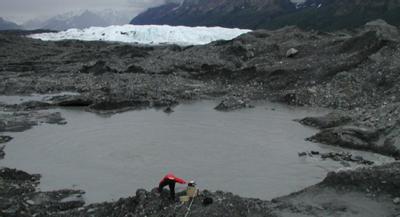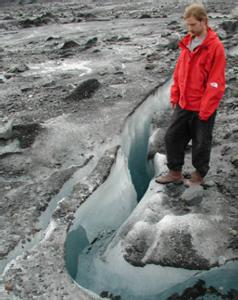10 July, 2000
July 10, 2000
Matanuska Glacier, Alaska
Last night there was a very different type of sound coming from the
distance. In addition to the usual sound of the rushing meltwaters of
the Matanuska River there was also the sound of heavy machinery in the
distance. For several days we had seen workers assembling a drainage
pipe that would be used to replace a much smaller one over the “Little
River”, one of a few streams that come out of the glacier and merge
downstream. The existing culvert system was much too small and would
wash out occasionally.
Unfortunately the crossing was not complete yet this morning in spite of
workers spending all night on it. So rather than heading onto the
glacier, we went back to camp to try out one more thing with the
fluorometer. Back in Indiana I had prepared standard solutions to use in
the calibration of the instrument. We decided to try making a new set
but with a slightly different procedure. Fortunately for us it gave much
improved results and we now feel confident in the instrument’s output.
The word came in just after lunch that the bridge was ready for vehicle
crossings and so we packed equipment up to head out once again. We now
had a second ISCO at our disposal. It had been dropped off yesterday by
someone from CRREL. It was decided to put this one at the Little River
Vent since this was, except for South Vent, the only one that was not
being monitored now. South Vent is extremely difficult to access and it
also happens to be the farthest from our moulins. In addition, Little
River Vent is closer to the moulins and seems to be in line, as is North
Vent, with the orientation of the large cracks in the ice.
We decided it might be helpful to our cause to dump the salt into the
moulin later in the day to take advantage of cooler temperatures. Last
night was very cool and that trend continued throughout the day today.
With the cooler temperatures and lack of sunshine there was less
meltwater running into the moulins. This would result in significantly
reduced dilution of the salt as it passed through the subglacial
drainage system.
After an early dinner we headed out to Trail Vent to put in fresh
batteries for the ISCO and set a new program for sampling. From there we
headed out onto the ice, both of us with a forty pound bag of salt in
each hand. It required several rest stops along the way but we managed
to get there at about the time we’d planned to. And in a matter of
minutes we dumped another 160 pounds of salt down moulin #2.
From there we walked still farther out on the glacier to look at the
more distant moulins that we might use should we make connections at
moulin #2. We discovered that quite a few new ones had formed. Some were
in the line of moulins we’d flagged earlier in the “moulin valley”. At
the same time we also noticed that some were definitely forming in the
cracks and that a few actually were lining up along a large crack that
seemed to run toward North Vent and Little River Vent.
It is now getting to be real intriguing. Some moulins line up along
cracks that point to the north. Still others line up along this sort of
valley that points toward Trail Vent to the west. The low flow of water
into the moulins was working in our favor to help keep the dilution of
the salt down. However as we walked back to the truck a light rain
developed and it is still doing so now, two hours later. It will be
interesting to see what happens when we pick up the samples tomorrow.
Till then.....
Marvin Giesting

Deploying the ISCO at Little River Vent. To the left is the rock covered northern portion of the terminus. In the distance is the beautiful southern portion. This vent drains to the west in the lower right side of the picture.

Ben is standing next to one of the moulins we found forming in the large cracks. You can see the original crack running back to the lower left corner. Might this one drain to North Vent or Little River Vent? By the way, the ice on the right of the crack is maybe 20 inches lower than the ice on the left.

There is now frazile ice forming at Trail Vent as the supercooled water exits the vent. To the right side is the glacier ice. To the left is the frazile ice forming from the vent. The ISCO sampling hose is seen at the top.
Contact the TEA in the field at
.
If you cannot connect through your browser, copy the
TEA's e-mail address in the "To:" line of
your favorite e-mail package.
|
